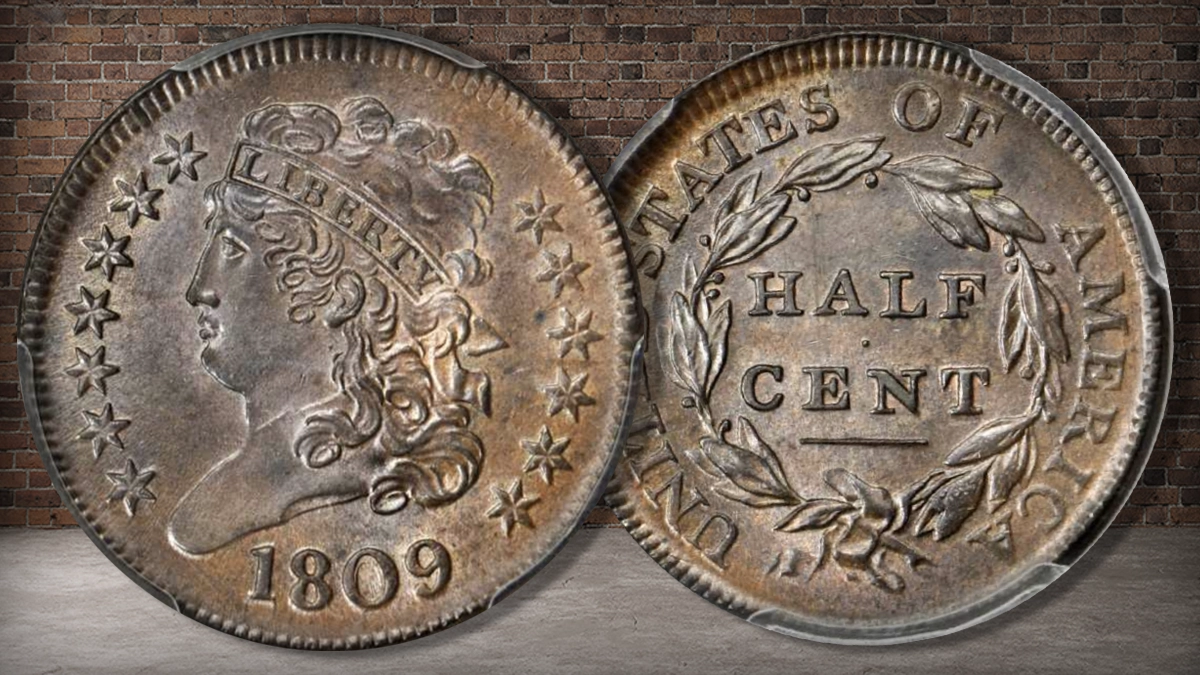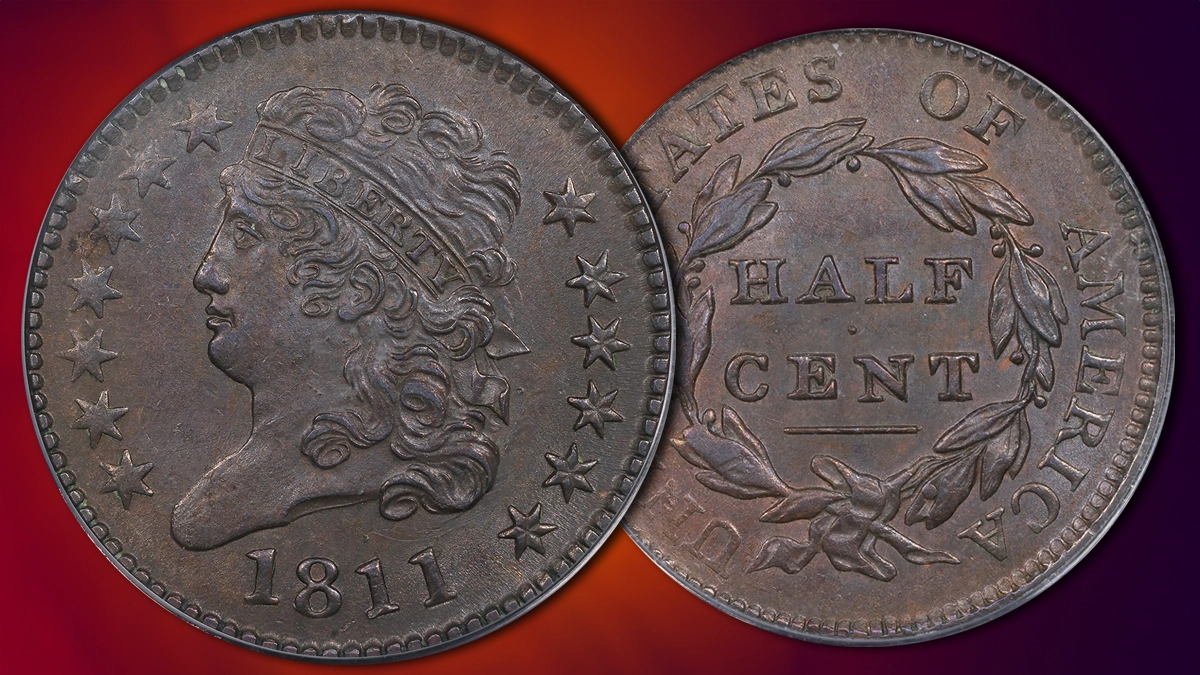
By Charles Morgan and Hubert Walker for CoinWeek Notes …..
The Classic Head Half Cent represents a period of significant change for the United States Mint.
Robert Patterson, a respected scholar with ties to Third President Thomas Jefferson, was appointed Mint Director in 1805. As Director, he was instrumental in the ascension of John Reich to the position of Second Engraver under Chief Engraver Robert Scot.
Reich came to this country from Germany as an indentured servant to get away from the Napoleonic Wars. Patterson gave to the talented Reich the responsibility of revamping the designs of U.S. coins, a task applied to the half cent for the 1809 issue. Chief Engraver Scot, unfortunately, was unwilling to give Reich the same credit for his abilities as did both the Mint Director and the President. After not receiving a pay raise in the nearly 10 years since his appointment, and seeing his designs modified by Scot during his tenure, Reich resigned from the Mint in 1817.
But while he worked there, Reich made a number of contributions to American coin design. Notable among them was his design of the half cent.
Reich’s portrayal of Liberty was more reserved than the previous Draped Bust design and was reminiscent of classical art, though the Classic Head name was not attached to the design until 1868 by Ebenezer Mason. Mason’s label was apparently due to the depiction of a fillet, Liberty’s narrow headband, that dates to ancient Greece. The depiction of the fillet was considered incongruous because only young males wore the band in ancient times, as a prize awarded to the winners of athletic contests.
A harsher criticism, born of rumor or disdain (or both), was that Liberty was a representation of Reich’s “fat mistress.”
The Tide Turns Against the Half Cent
There were issues more serious than those of artistic merit, however. By 1809, the growth of commerce in this country was minimizing the value of the half cent as a denomination for transactions. This situation, combined with a shortage of copper planchets from the English firm of Boulton & Watt during the War of 1812, resulted in suspension of half cent production after 1811.
Minting of half cents resumed in 1825, presumably in response to orders by a Baltimore merchant, though the new coins had design modifications by Chief Engraver William Kneass (Scot died in 1823 and Reich had left years earlier).

Even with the orders, more half cents were produced than needed, and no coins of the denomination were minted in 1827 or 1830, though production resumed in 1831. 1836 half cents were made only as Proofs, and in the mid-19th century restrikes of some dates, both circulation and Proof, were made. No half cents were produced from 1837 through 1839, but some include an 1837 privately issued Hard Times token as part of a period half cent collection.
How Much Are Classic Head Half Cents Worth?
A few thousand business strike Classic Head Half Cents have been certified, though some varieties and color types are represented by fewer than 100 pieces, and some by fewer than 10 examples.
Coins are described as Brown (BN), Red-Brown (RB), or Red (RD), with RB examples less common than BN, and RD the most scarce.
Prices are moderate for many issues up to MS63, but are expensive finer than that, particularly for RB and the scarce RD examples.
Higher priced dates include 1811 and 1831, the latter the most expensive coin of the type.
Very few Proof examples were minted, from 1831 through 1836, though one Specimen example for 1811 is listed in census/population reports. Many Proofs are restrikes, all are rare and expensive at PR60 to very expensive as PR63 and finer; all Original 1831 Proof half cents are very expensive.
Varieties
Half cents, like most coins struck before the advent of steam coinage is frequently collected by variety. Several varieties are known in the Classic Head Half Cent series, including the 1809 Small o Inside O and 9 Over Inverted 9; 1811 Wide Date, Close Date, and Reverse of 1802 (restrike); 1828 13 Stars and 12 Stars; 1831 Large Berries Reverse of 1836 and Small Berries Reverse of 1840-1857 (restrike, Proof); 1836 Reverse of 1840-1857 (restrike, Proof); and other minor die varieties.
CoinWeek Exclusive Coverage of the Classic Head Half Cent
In Part 20 of his series on Classic U.S. coins that can be bought for less than $500 (at the time of publication, anyway), CoinWeek contributor Greg Reynolds explored the market for the Classic Head Half Cent.
Design
Obverse:
Reich’s Liberty faces left, displaying a more reserved and mature countenance than the previous Draped Bust type. Her long, curling hair drapes over the forehead, around the ear, down the side and back of the neck, and is tied at the back. The headband prominently displays the word LIBERTY across the facing side. A circle of dentils or beads follows along the rim. Thirteen six-point stars frame the portrait, seven to the left and six to the right; a notable 1828 variety has 12 stars, seven to the left and five to the right. The date is located below the portrait at the bottom.
Reverse:
The reverse features a denticled rim, within which is a concentric circle formed by UNITED STATES OF AMERICA, broken at the bottom by the tied ends of a laurel branch with berries that forms an inner wreath. At the center is the denomination of HALF CENT, the words on separate lines with a centered dot between; a short horizontal line is under CENT.
Coin Specifications
| Classic Head Half Cent | |
| Years Of Issue: | 1809-36 |
| Mintage (Business Strikes): | High: 1,154,572 (1809); Low: 51,000 (1832, Estimated mintage) |
| Mintage (Proof): | None reported or known, 1809-1829; ±25 (1831-1836, estimated) |
| Alloy: | Copper |
| Weight: | 5.44 g |
| Diameter: | 23.50 mm |
| Edge: | Plain |
| OBV Designer | John Reich, modified by Robert Scot and William Kneass |
| REV Designer | John Reich, modified by Robert Scot and William Kneass |
* * *
References
Bowers, Q. David. The Experts Guide to Collecting & Investing in Rare Coins. Whitman Publishing.
–. A Guide Book of United States Type Coins. Whitman Publishing.
Breen, Walter. Walter Breen’s Complete Encyclopedia of United States Coins. Doubleday.
-. Walter Breen’s Encyclopedia of Early United States Half Cents, 1793-1857. American Institution of Numismatic Research.
Early American Coppers (EAC). www.eacs.org.
Guth, Ron and Jeff Garrett. United States Coinage: A Study by Type. Whitman Publishing.
Noyes, William C. United States Large Cents, 1793-1814. William C. Noyes.
Sheldon, William H. Penny Whimsy. Quarterman Publications.
Taxay, Don. The U.S. Mint and Coinage. Arco Publishing.
Yeoman, R.S and Jeff Garrett (editor). The Official Red Book: A Guide Book of United States Coins. Whitman Publishing.
* * *




